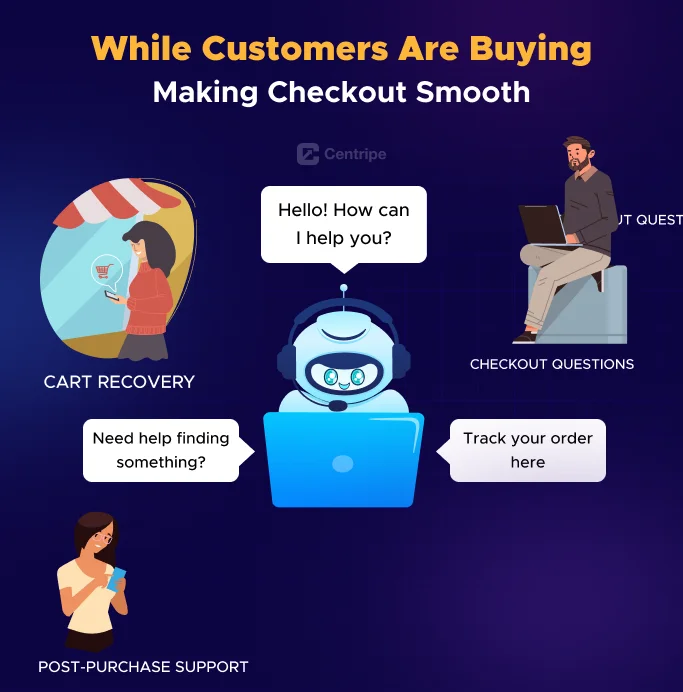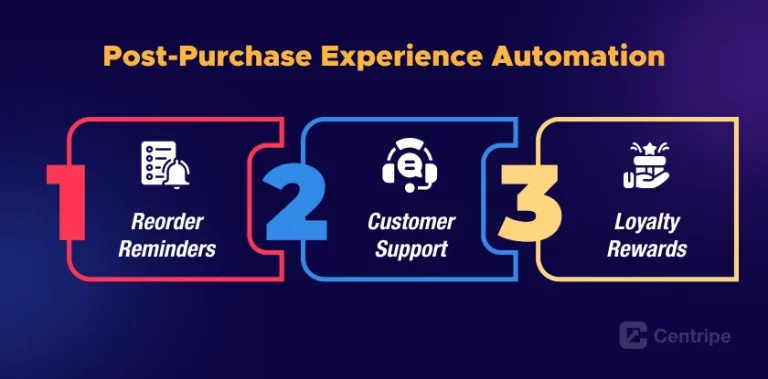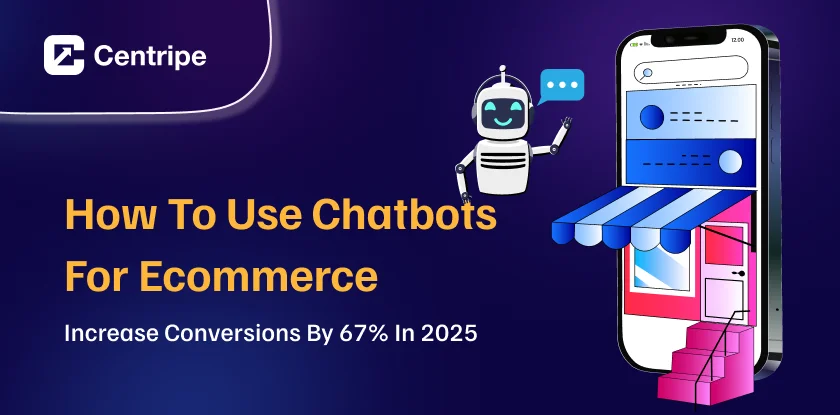Your brand image is a reflection of customer satisfaction!
What if someone is there to help shoppers online in buying products. What if the customers buy more from your brand? This is possible with the help of chatbots.
If the sales person is good, there is a high chance, that shoppers will buy more. Someone who was about to buy product from different brand, will take from yours. In online shopping this bridge is filled by ecommerce chatbot.
Without an ecommerce chatbot, businesses are losing an average of $62 billion annually in abandoned carts
With online markets the ecommerce competition has surged. Why would the customer buy same product from you, if it is being offered by others too?
You will say ‘We offer best quality.’ But what if quality is the same too? There comes the ‘care’ factor. The more you care about them, the more they become loyal to you.
What Is an Ecommerce Chatbot?
Take a scenario, where a customer is stuck on sizing, guessing about the shipping times, or desperately hoping that the limited edition item will restock, and its all happening after working hours.
Customers want instant help. You are not there to assist them, and bang,,,, they switched to different brand.
An ecommerce chatbot is AI software that chats with your online shoppers as they shop.
These shopping assistant bots stand out from regular websites. They engage people in real conversations.
They answer questions, suggest products, and close sales. These tools use NLP and ML.
They understand what customers want. This could be tracking a package late at night or finding the right gift during the holiday rush.
Types of Ecommerce Chatbots: Choosing the Right For your business
1. Rule-Based Chatbots
Think of these as helpful robots that follow a script. They work like a flowchart – when customers ask “What’s your return policy?” the bot knows exactly which pre-written answer to give.
They’re perfect for answering common questions. This includes store hours, shipping info, and basic product details. These are simple, and better for businesses that are yet to begin with chatbots.
2. AI-Powered Chatbots
The smartest one in tech world right now. They can understand what customers really mean, even when they don’t ask perfectly.
If a user types “I need something warm for winter,” the bot knows they want winter clothes. It can then suggest coats, sweaters, or boots.
They learn from chats and improve over time. Shopping feels more like talking to a smart friend.
3. Live Chat Handoff Bots
These work like a tag team. The bot takes care of simple tasks first. It checks order status, finds products, and answers basic questions.
But when things get tricky or personal, they smoothly pass the conversation to a real human agent.
It’s like having a smart assistant. They know when to involve the manager, so customers get the best of both worlds.
Each type meets different business needs. Some handle simple FAQs, while others provide complex, personal customer support.
Centripe.ai’s Aeri: the best chatbot for Ecommerce
Smart Customer Understanding
Aeri works like having a knowledgeable store assistant who never sleeps.
It replies instantly with accurate information, when customers ask ‘Do you have this in brown?’ or ‘When will my order arrive?’
So there is no need of waiting for human agents.
Seamless Shopping Experience
Think of Aeri as your digital sales helper. Aeri guides customers through their whole journey.
The shoppers can find products, compare the features, check stock, even make orders, etc.
Now this all happens in smooth natural conversation, so the customers have a great experience shopping with your brand.
Smart Integration with Your Store
Aeri connects directly with your ecommerce platform, inventory system, and customer database.
It always knows what’s in stock. It tracks order status in real-time. It also remembers customer preferences for better recommendations.
Ecommerce chatbots use cases that drive conversions
Where Should I deploy chatbots for Maximum Impact?
Placing chatbots in the right spots on your website is like putting helpful store assistants where customers need them. Let me break down the best locations and explain why they work so well.
Before Customers Buy: Turning Visitors Into Shoppers
Helping people find what they want.
When a visitor comes at your website, the chatbot can start conversation with ‘What are you looking for today?’
Then it gets more specific – maybe asking if they need something for work or a special event.
A smart chatbot shows customers only 3-5 ideal products instead of hundreds. This way, it focuses on what they really want.
This makes shopping feel easy and personal instead of overwhelming.
Sephora does this really well with their makeup chatbot. It helps customers pick the right foundation shade or lipstick colour by asking easy questions.
Thanks to this helpful approach, 11% more people make a purchase. They spend 8% more money, and customers are 15% happier with their experience.
Finding Your Best Potential Customers
Savvy business owners use chatbots to find potential buyers. The chatbot knows when someone is really shopping.
They might be checking out several products or spending a lot of time on your site.
At this particular moment, the chatbot can offer a discount code with their email address. So you can follow up with people who are actually interested in buying the products.
Bringing Back People Who Almost Bought Something
Here’s a frustrating fact: about 70 in 100 people add items to their online carts but leave without buying.
The chatbots become essential in such scenarios. When it notices someone is about to leave with items in their chart, it can pop up and offer assistance.
The shopper might be worried about shipping costs, or are not sure about the size.
So the customer service chatbot for ecommerce will quickly handle these concerns. It also offers free shipping or create by mentioning ‘Only few items are left.’
While Customers Are Buying: Making Checkout Smooth

Answering Questions Right Away
Nothing kills a sale faster than confusion during checkout.
A chatbot is ready to help with sizing, shipping costs, or payment options. Customers don’t leave to think. They get quick answers and can buy immediately.
This is especially important for first-time customers. They may feel nervous about ordering from a new website.
Suggesting Additional Items That Make Sense
When used well, chatbots can boost spending by 10-30% by recommending related items. Do not push the customers instead be helpful.
If someone is buying a winter coat, then the chatbot will suggest a matching scarf or gloves, kind of cross-selling.
The suggestions should feel natural and genuinely useful.
After Customers Buy: Keeping Them Happy
Order Help Made Simple
Customers ask “Where’s my order?” or “Can I change my address?” A chatbot answers instantly. No waiting for calls or emails. It shows order status, handles returns, and creates return labels in seconds.
Stop Problems Before They Start
Smart chatbots send shipping updates automatically. They share product care tips and remind customers when to reorder. This keeps customers happy and coming back.
Easy Loyalty Rewards
Chatbots make reward programs simple. Customers check points, redeem rewards, and see what they need for the next level – all in one chat.
The Bottom Line
Place chatbots where customers need help most: product search, checkout, and after purchase. This creates smooth shopping that keeps people coming back.
Using Ecommerce chatbots where your customers are:
On Social Media: Meeting Customers Where They Already Are
Facebook Messenger
There are nearly 3 billion Facebook users. A chatbot on messenger acts like a store assistant for potential customers.
The integration with the software will let the customers browse your products without ever leaving Facebook.
Offer special offers to people who showed interest in your products but didn’t buy due to any reason.
Shopping feels easy and natural because people already spend time on Facebook.
Instagram Direct Messages
From small to big, every companies have shifted to instagram for marketing. It has become a choice for everyone and why not? The interactive interface is splendid.
Your chatbot can respond to questions in comments or direct messages.
If you use influencers to promote your products, the chatbot can reply to all their followers’ questions.
People can even buy products directly through Instagram without going to another website.
WhatsApp Business
On Whatsapp you can send order confirmations, shipping updates and also deliver alerts.
Businesses can create a product catalogue in WhatsApp. So customers can brose and buy without leaving the app, just like messenger.
Customers feel safe buying on WhatsApp because their messages are secure and private.
Benefits of AI Ecommerce Chatbots:
1. Proactive Cart Recovery
Proactive chatbot help can recover 15-35% of abandoned carts. It can also boost average order value by 10-15%.
Chatbots can spot when customers hesitate at checkout. Then, they can step in with tailored offers or help.
They can quickly address issues like shipping costs, return policies, or product questions.
This helps prevent customers from leaving their carts. This proactive approach recovers sales that would otherwise be lost, directly impacting revenue.
2. Instant Product Discovery Through Conversational Search
Chatbots help customers by understanding natural language. They can answer questions like, “Show me waterproof boots for hiking under $100.”
This helps make product searches easier.” They can ask questions about preferences, style, and needs. This helps them find the perfect products quickly.
This saves time spent browsing and helps customers quickly find products to buy.
3. Dynamic Cross-Selling Based on Real-Time Behavior
Chatbots look at what customers browse and buy. They suggest extra products at the best time while shopping.
They can show why some combinations work well, unlike the standard “customers also bought” sections.
This boosts average order value by providing smart, timely recommendations. They feel helpful, not pushy.
4. Post-Purchase Experience Automation

Chatbots can help customers onboard. They offer usage tips, gather feedback, and spot upselling chances after a purchase.
They can reach out with maintenance reminders, reorder ideas, or special offers. These are based on what customers have bought before.
This builds long-term customer loyalty and increases lifetime value beyond the initial transaction.
5 Best Practices for Using Chatbots in Ecommerce
1. Start Simple, Then Grow
Building a perfect chatbot right away is a major mistake that most of the businesses do. Start with basic tasks such as answering common answers, checking order status, or helping with returns.
Once the customers are comfortable and your bot is doing well, add features like product recommendations or better troubleshooting.
2. Make Human Handoff Super Easy
Always pave a clear way of talking. Add phrases like ‘speak to agent’ or ‘talk to human button’.
Train the human agents to pick up where the chatbot left off, so that customers don’t have to repeat themselves.
3.Use Customer Data Smartly
Connect the chatbot with database. When someone returns the products, the bot should know their purchase history, preference and past issues.
4. Place Chatbots Where They’re Needed Most
Put chatbots on key pages:
- Product pages (for questions about features)
- Checkout page (for payment or shipping help)
- Customer service page (for support issues)
- Cart abandonment pop-ups (to solve problems preventing purchase)
5. Track Performance and Keep Improving
Monitor these key metrics:
- Conversation completion rate
- Customer satisfaction scores
- How often chats get transferred to humans
- Sales generated through chatbot interactions
Improve your bot’s responses using this data. Also, add new features that customers really want.
Make Your Chatbot Easy to Use
Be Clear From the Start
Tell customers what your chatbot can do right away. Make it easy to reach a human – just type “talk to person” or click a button. Being honest builds trust.
Sound Like Your Brand
If your brand is fun, make the chatbot fun too. If you’re professional, keep it professional. Avoid robot language – talk like a real person would.
Make It Personal
Remember what customers bought before and suggest related items. Remember their location for accurate shipping times. Don’t make them repeat themselves every time they chat.
Keep Improving
Track if customers are happy and if conversations end well. Test different greeting messages and conversation styles to see what works better.
Connect Everything
Your chatbot should work with your store, customer service, and payment systems. This way customers get accurate info and smooth experiences.
Keep Data Safe
Protect customer information like addresses and payment details. Follow privacy laws and use secure encryption. Be clear about what data you collect.
Remember: Every chat is with a real person who wants help. Focus on making their experience better.
Conclusion:
Ecommerce chatbots are now vital for online businesses, not just optional tools. They provide support all day, every day. They boost sales with clever recommendations and improve the shopping experience for customers.
Success lies in using chatbots effectively throughout the customer journey. This starts from product discovery and goes to post-purchase support. A smart strategy can change casual visitors into loyal customers. It can also reduce support costs.
Customers want more, so businesses with smart chatbots will do better than those using old support methods. The future belongs to companies that make shopping easy and personal through automation.
